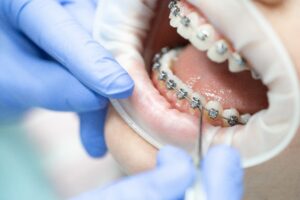Have you ever felt a phantom pain in your mouth? A sporadic ache in your teeth that comes and goes, particularly when you are eating cold food or drinking a hot drink?
If so, you may have a cracked tooth.
Teeth enamel is the hardest substance in your body, even stronger than your bones. However, it is possible for teeth to fracture. Teeth grinding, chewing hard foods (such as ice, nuts, or hard candy), hard blows to the mouth, or abrupt changes in temperature—for instance, eating something extremely hot and then cooling your mouth with cold water—can all cause tooth cracks. Simply getting older can also cause teeth fractures, with most cracks occurring in people over 50 years old.
How can I tell I have a cracked tooth?
Unfortunately, a cracked tooth is often difficult to diagnose. Even an x-ray won’t reveal tooth fractures, and cracked teeth can present a variety of different symptoms. Some cracks are harmless and do not require treatment. However, if you have the following symptoms, you may have a more extensive kind of crack that requires dental treatment with Dr. Stallings:
● Pain when eating or drinking
● Sensitivity to hot and cold temperatures or sweet foods
● Inconsistent, throbbing mouth pain
● Swollen gums
● Bad breath
● Sore neck glands
Untreated cracks can cause infections and make it difficult to save your tooth. Call Stallings Dental as soon as possible if you are showing some of these symptoms.
What can Dr. Stallings do to help my tooth?
Treatment for a broken or chipped tooth will depend on how severe the damage to the tooth is. Here are Dr. Stallings’ primary ways to treat a cracked tooth:
● Dental fillings: Fillings are best for teeth with minimal enamel damage. Fillings are bonded on the tooth using a tooth-colored composite resin, which makes this kind of treatment perfect for use in visible parts of teeth. The bonding process does not require numbing the teeth and can be done in a single office visit.
● Dental caps or crowns: If a larger piece of the tooth cracks or breaks off, a cap or crown may be required. In this case, Dr. Stallings will grind or file away the decayed part of the remaining tooth and cover it with a tooth-shaped cap. Permanent crowns can be made with multiple different materials, including gold, silver, resin, and ceramic. (Talk to Dr. Stalling for more information on choosing the crown material that works best for you.) Getting a crown typically requires two office visits: the first visit to get impressions of the tooth and place a temporary crown, then the second two of three weeks later to cement the permanent crown.
● Dental veneers: If the front tooth has a large chip or break, a dental veneer may be the best option. A dental veneer is a tooth-colored porcelain or resin composite material that covers the whole tooth, with a thicker part that replaces the broken section.
● Root canal therapy: When a tooth break is large enough to expose the center of the tooth—also called the pulp—bacteria from the mouth can enter and infect the nerves and blood vessels there. Without treatment, the tooth can become infected and need to be extracted. Root canal therapy involves removing the dead parts of the teeth, cleaning the root canal, and sealing it.
What can I do at home to help the pain?
● Avoid eating foods that are difficult to chew.
● Take over-the-counter pain relievers like ibuprofen.
● Cover any sharp or jagged edges with wax paraffin or sugar-free gum.
● Use a cold compress to reduce swelling.
● If you have a mouthguard or retainer, wear it to prevent grinding and clenching that can further damage the tooth




